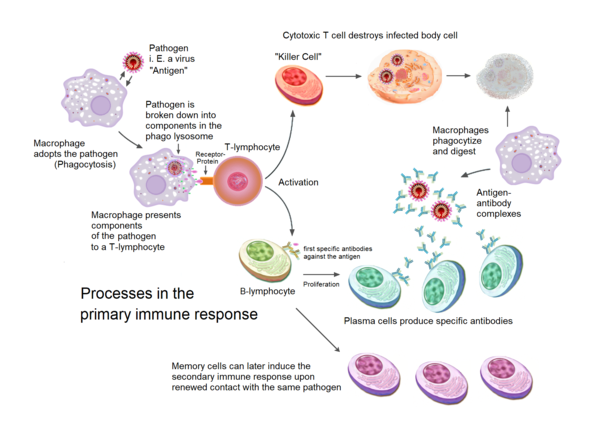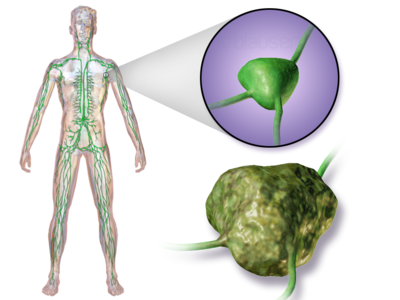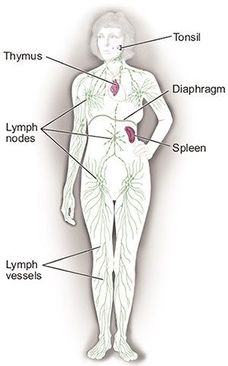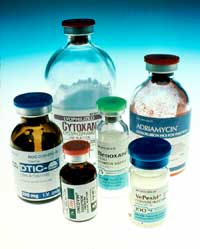Non-Hodgkin's Lymphoma
Original Editors - Jen Bognich from Bellarmine University's Pathopysiology of Complex Patient Problems project.
Top Contributors - Jen Bognich, Lucinda hampton, Admin, Kim Jackson, 127.0.0.1, Evan Thomas, WikiSysop, Vidya Acharya, Elaine Lonnemann and Wendy Walker
Introduction[edit | edit source]
Non-Hodgkin lymphoma (NHL) is a neoplasm of the lymphoid tissues, which originates from B cell precursors, mature B cells, T cell precursors, and mature T cells.
Non-Hodgkin lymphoma accounts for about 90% of all lymphomas, and the remaining 10% are referred to as Hodgkin lymphoma.
- Non-Hodgkin lymphoma comprises of various subtypes, each with different epidemiologies, etiologies, immunophenotypic, genetic, clinical features, and response to therapy. It can be divided into two groups, 'indolent' and 'aggressive' based on the prognosis of the disease.
- The most common mature B cell neoplasms are Follicular lymphoma, Burkitt lymphoma, diffuse large B cell lymphoma, Mantle cell lymphoma, marginal zone lymphoma, primary CNS lymphoma. The most common mature T cell lymphomas are Adult T cell lymphoma, Mycosis fungoides.
- The treatment of NHL varies greatly, depending on tumor stage, grade, and type of lymphoma, and various patient factors (e.g., symptoms, age, performance status)[1].
- Non-Hodgkin's lymphoma (NHL) [2] have a wide range of histological appearances and clinical features at presentation, which can make diagnosis difficult[3].
- Lymphomas are not rare.
- Timely diagnosis is important because effective, and often curative, therapies are available for many subtypes[3].
Etiology[edit | edit source]
Non-Hodgkin lymphomas (NHL) may be associated with various factors, including infections, environmental factors, immunodeficiency states, and chronic inflammation.
- Various viruses have been attributed to different types of NHL.
- Epstein-Barr virus, a DNA virus, is associated with the causation of certain types of NHL, including an endemic variant of Burkitt lymphoma.
- Human T-cell leukemia virus type 1 (HTLV-1) causes adult T-cell lymphoma. It induces chronic antigenic stimulation and cytokine dysregulation, resulting in uncontrolled B- or T-cell stimulation and proliferation.
- Hepatitis C virus (HCV) results in clonal B-cell expansions. Splenic marginal zone lymphoma and diffuse large B cell lymphoma are some subtypes of NHL due to the Hepatitis C virus.
- Helicobacter pylori infection is associated with increased risk of gastric mucosa-associated lymphoid tissue (MALT) lymphomas, a primary gastrointestinal lymphoma.
- Drugs like phenytoin, digoxin, TNF antagonist are also associated with Non-Hodgkin lymphoma. Moreover, organic chemicals, pesticides, phenoxy-herbicides, wood preservatives, dust, hair dye, solvents, chemotherapy, and radiation exposure are also associated with the development of NHL.
- Congenital immunodeficiency states associated with increased risk of NHL are Wiskott-Aldrich syndrome, severe combined immunodeficiency disease (SCID), and induced immunodeficiency states like immunosuppressant medications. Patients with AIDS (Acquired immunodeficiency syndrome) can have primary CNS lymphoma.
- The autoimmune disorders like sjögren syndrome, rheumatoid arthritis, and Hashimoto thyroiditis are associated with an increased risk of NHL. Hashimoto's thyroiditis is associate with primary thyroid lymphomas. Celiac disease is also associated with an increased risk of non-Hodgkin lymphoma[1].
Epidemiolgy[edit | edit source]
There are geographical variations in the incidence of individual subtypes:
- Follicular lymphoma being more common in Western countries,
- T cell lymphoma more common in Asia.
- Overall, Non-Hodgkin lymphoma is common in age 65 to 74, the median age being 67 years.
Epstein-Barr
- virus-related (endemic) Burkitt lymphoma (BL) more common in Africa
- endemic variant of Burkitt lymphoma is found in equatorial Africa and New Guinea.
- incidence of Burkitt Lymphoma in Africa is approximately 50-times higher than in the United States
- peak incidence in children is between age four to seven years, and the male: female ratio is approximately 2 to 1.
- sporadic variant of Burkitt lymphoma is seen in the United States and Western Europe.
- BL comprises 30 percent of pediatric lymphomas and <1 percent of adult non-Hodgkin lymphomas in the United States.
Mantle Cell Lymphoma consists of about 7 percent of adult non-Hodgkin lymphomas in the United States and Europe with an incidence of approximately 4 to 8 cases per million persons per year. Incidence increases with age and appears to be increasing overall in the United States. The median age at diagnosis is 68 years.
- Non-Hodgkin lymphoma is the fifth most common diagnosis of pediatric cancer in children under the age of 15 years, and it accounts for approximately 7 percent of childhood cancers in the developed world.
- Lymphomas are rare in infants (≤1 percent)[1]
B-cell lymphomas: account for approximately 85% of non-Hodgkin lymphomas in the United States. [5]
T-cell lymphomas: account for less than 15% of non-Hodgkin lymphomas in the United States. [5]
Characteristics/Clinical Presentation[edit | edit source]
- Patients present with complaints of fever, weight loss, or night sweats, also known as B symptoms.
- Systemic B symptoms are more common in patients with a high-grade variant of non-Hodgkin lymphoma.
- More than two-thirds of the patient presents with painless peripheral lymphadenopathy.
- Waxing and waning episodes of lymphadenopathy, along with other symptoms, can be seen in low-grade lymphoma.
- Enlarged lymph nodes
- Pallor
- Fatigue
- Bleeding
- Infection
- Red skin & generalized itching of unknown origin
- Pain in the chest, abdomen or bones for unknown reason[2][6][7]
Patients have different presentations and vary according to the site involved.
- Burkitt Lymphoma: Patients often have rapidly increasing tumor masses. This type of lymphoma may present with tumor lysis syndrome.
- Endemic (African) form may have a jaw or facial bone tumors in 50 to 60 percent of cases. The primary involvement of the abdomen is less common. The primary tumor can spread to extranodal sites like mesentery, ovary, testis, kidney, breast, and meninges[1].
- About 50 percent of patients may develop the extranodal disease (secondary extranodal disease), while between 10 and 35 percent of patients will have primary extranodal lymphoma at the time of diagnosis[1]. Extranodal sites of involvement may include the nasopharynx, GI tract, bone, thyroid, testes and soft tissue. Abdominal lymphoma may cause abdominal pain & fullness, GI obstruction or bleeding, ascites, back pain & leg swelling. Lymph node enlargement in the chest can lead to compression of the trachea or bronchus, causing shortness of breath & coughing.[6]
- Primary CNS lymphoma is a NHL restricted to the nervous system. Presenting symptoms may include: headache, confusion, seizures, extremity weakness/numbness, personality changes, difficulty speaking & lethargy. (Prior to the spread of HIV, this type of lymphoma was rare.)[6]
Medications/Treatment[edit | edit source]
"Treatment varies for NHL depending on the type of lymphoma. In general, fast-growing tumors can be cured but require aggressive treatment; whereas, slow-growing tumors often cannot be cured, but the clinical course is chronic and the therapy is often reserved until symptoms develop. Localized disease may be treated with radiation, whereas disseminated disease requires radiation and chemotherapy."[6] Information about the drugs used in the treatment of NHL can be found at this link: Non-Hodgkin's Lymphoma Medication. [8]
"The most common chemotherapy combination is CHOP (cyclophosphamide, doxorubicin, vincristine & prednisone). Another combination omits the doxorubicin (because of the effects on the heart) and is called CVP. Other agents include chlorambucil, fludarbine, & etoposide. Since many risk factors for NHL are associated with a reduced immune system, immune modulators, such as interferon and monoclonal antibodies, have been employed to combat NHL."[6]
"Combining the monoclonal antibody rituximab (Rituxan)[9] with chemotherapy (CHOP) has produced high rates of response and is the treatment of choice for many NHLs. Clinical studies suggest that the immune modulator rituximab may alter the sensitivity of B-cell lymphoma to chemotherapy as well as induce apoptosis and cause the lysis of B cells."[6]
"Bone marrow transplant (BMT) may be used for patients who replace or do not completely respond to treatment (which often occurs with aggressive lymphomas). Combined with intensive chemotherapy, BMT can be curative. In 2002, 4,300 BMTs were performed."[6]
"For some lymphomas, chemotherapy becomes palliative because of an inability to overcome drug resistance within the lymphoma cells; attempts at overcoming specific drug resistance mechanisms have had limited success. Other strategies involve the use of antigen-presenting cells for taking up, processing, & presenting tumor protein in a vaccine strategy. This may provide a new tumor cells that persist following therapy. Radioimmunotherapy, radioactive labeling of a monoclonal antibody, is also under investigation to provide targeted therapy & provide tumor-free grafts for transplant."[6]
"The optimal management of women with NHL who are pregnant requires special considerations because of the poor prognosis without treatment. Treatment during the first trimester should be avoided due to the risk of harm to the fetus, but the patient should receive chemotherapy during the second and third trimester despite the potential risk to the fetus."[6]
Diagnostic Tests/Lab Tests/Lab Values[edit | edit source]
- Physical Exam & History: An exam of the body to check general signs of health, including checking for signs of disease, such as lumps or anything else that seems unusual. A history of the patient's health habits and past illnesses and treatments will also be taken.[7]
- Complete Blood Count (CBC):[7] includes the: number of red blood cells, white blood cells & platelets, amount of hemoglobin in the red blood cells, proportion of blood that is made up of RBCs
- Blood Chemistry Studies: blood sample is checked to measure the amount of certain substances released into the blood by organs & tissues in the body. An abnormal count can be associated with a sign of disease in the organ or tissue.[7]
- Lymph Node Biopsy: is viewed by a pathologist to look for cancer cells.[7]
- Bone Marrow Aspiration & Biopsy: is the removal of bone marrow, blood & a small piece of bone from the hip or breastbone.[7]
- Liver Function Tests: the blood is checked for the enzyme lactate dehydrogenase (LDH). LDH levels help determine the prognosis and chance of recovery.[7]
"Accurate diagnosis is important because of the other clinical conditions that can mimic malignant lymphomas (infection, tuberculosis, SLE, lung & bone cancer). Molecular genetic techniques that take advantage of the clonal nature of this malignancy are now being used to better characterize & diagnose the lymphomas. A biopsy is required to confirm the underlying cause of persistent enlargement of lymph nodes present."[6]
"CT scans of the chest, abdomen and pelvis are helpful in staging, while MRI is used to image the brain and spinal cord. Bone marrow may be examined for staging and peripheral blood may be tested, but blood abnormalities are not present until the disease is in an advanced stage. If clinical symptoms warrant, a lumbar puncture for spinal fluid may be performed. Immunohistochemistry, flow cytometry or cytogenetic testing is often done to distinguish one type of NHL from another."[6]
"The gallium scan using radiotracer, gallium-67, uptake is 85% to 90% accurate to predict residual disease after chemotherapy and is able to differentiate between active tumor tissue and fibrosis. PET imaging is becoming more widespread and can be performed to aid in the initial diagnosis and help ascertain if a lymph node is malignant or benign. PET is also used following chemotherapy (frequently along with CT) to determine if the lymphoma is reduced in size and the treatment is effective."[6]
Prognosis[edit | edit source]
"Good prognostic features include age under 60 years, limited disease at diagnosis (stage I or II), lack of extranodal disease, and a normal lactate dehydrogenase (LDH) level. Individuals with NHL survive for long periods when involvement is only regional. The presence of diffuse disease reduces survival time. The indolent lymphomas are usually systemic & widespread and a cure cannot be achieved, whereas intermediate and fast-growing lymphomas are more likely to be treatable & even curable but require aggressive therapy."[6]
"The prognosis for people with high-grade lymphomas depends on their response to treatment. More specifically, DLBCL can be cured in 40% to 50% of clients with therapy, follicular lymphoma has a 5-year survival of 60% to 70% (although it is eventually fatal), 20% of patients with mantle cell are alive at 5 years, and Burkitt's lymphoma has a 50% 5-year survival with intensive therapy. In general, the 5-year survival rate for NHL is 63% and the 10-year survival rate is 49%."[6]
"Traditionally high-grade NHL associated with AIDS was synonymous with an extremely poor prognosis. But the advent of antiretroviral therapy for HIV the survival rates have approached those seen in individuals without HIV. Prognostic indicators for decreased survival rates in HIV-NHL include age greater than 35 years, history of injection drug use, CD4 cell count less than 100/100 ml, a history of AIDS before the diagnosis of lymphoma stage III or IV disease, and/or elevated LDH levels."[6]
Medical Management[edit | edit source]
Radiation therapy uses high energy rays to carefully and safely kill cancer cells while attempting to avoid the destruction of healthy cells. 'Radiation therapy is used to try and cure cancer, control the growth and spread of cancer and relieve symptoms, such as pain. The most common type is external beam radiation therapy, which is a series of daily outpatient treatments to accurately deliver radiation to the cancer cells. Treatment sessions usually last less than 30 minutes. Total nodal irradiation is radiation delivered to all lymph nodes in the body. Total body irradiation is radiation delivered to the entire body, usually prior to any transplants to kill all remaining cancer cells.'[11]
"Chemotherapy[12] is the use of drugs to kill cancer cells and shrink tumors. Chemotherapy drugs are designed to attack rapidly dividing cells. Therefore, the drugs are not specific to cancer cells and will also be cytotoxic to normal, noncancerous cells. Patient's experience serious side effect, often secondary to the destruction of healthy, normal, noncancerous cells. Common side effects include: nausea, vomiting, diarrhea, hair loss, weight loss, mouth sores, depression and leukopenia. More serious side effects include: neutropenia, anemia, peripheral neuropathy, thrombocytopenia, kidney and liver damage, tumor lysis and/or allergic reactions."[12] Common chemotherapy drugs are developed from two different agents:
- Alkylating Agent: A cytotoxic (toxic to cells) agent that inhibits cell division by reacting with DNA[12].
- Nucleosides: These inhibit DNA and RNA replication and thereby prevent cancer cells from growing[12].
There is research being done to develop a vaccination against lymphoma.[13] The vaccine itself is made by extracting cells from lymph nodes and identifying a cancer marker, called an "idiotype," that is unique to each patient. This idiotype is then fused with chemicals designed to stimulate the immune system. This vaccine have shown promising results[14] but are not able to cure anyone who currently has lymphoma or prevent anyone from developing lymphoma. The vaccination is a form of chemotherapy and has shown significant success in lengthening the time period before the cancer returns.
Physical Therapy Management[edit | edit source]
"Exercise, even if it is only minimal physical exertion, increases heart rate and muscle flexibility. It can also boost the body’s tolerance to conventional lymphoma cancer treatments, such as, chemotherapy and radiation. Taking part in a daily exercise program can also help the patient gain a sense of physical control over their condition, and provide a healthy outlet for stress and anxiety. Exercise programs that combine range of motion with other light activities like resistance training and aerobic exercise will provide positive health benefits. The Borg Scale of Rating of Perceived Exertion (RPE) is most often used during exercise because of the limiting qualities of cancer treatments.
A Flexibility Program is often implemented to help relieve joint stiffness and pain while helping maintain good range of motion. The benefits of stretching include:
- Enhancement in performance of everyday activities
- Improvement in mobility and independence
- Improvement and maintenance in posture and muscle balance
- Injury prevention
- Promotion of physical and mental relaxation
The physical therapy intervention that is most effective in providing an increased quality of life and improved endurance is Aerobic Exercise. Study results suggest that treadmill exercises provide cardioprotective effects on the Doxorubicin-induced cardiotoxicity[15].
Helping patient's maintain an active lifestyle increases their chance of survival. Instructions in a home exercise program (HEP) that consists of ankle range of motion, lower extremity strengthening and aerobic exercise can help them maintain normal gait mechanics and allow a quicker recovery after treatment.
The following links support the use of aerobic exercise:
- Palliative and Supportive Treatment: Randomized Control Trial[16]
- Effects of Physical Therapy on Acute Lymphoblastic Leukemia.[17]
Differential Diagnosis[edit | edit source]
The differential diagnosis of Non-Hodgkin Lymphoma involves the ruling out of obvious and common conditions as well as other possible malignancies. The exact diagnosis hinges on the histological findings and the opinion of an experienced hematopathologist.[18]
"In patients with cervical adenopathy (enlargement or disease of glands), infections, including bacterial or viral pharyngitis, infectious mononucleosis and histoplasmosis must be excluded. Other malignancies, such as nasopharyngeal and thyroid cancers, can present with localized cervical adenopathy and axillary adenopathy is a common metastatic manifestation of breast cancer. Mediastinal lymphomatous involvement must be distinguished from infections, sarcoidosis and other thoracic neoplasms."[18]
The two main presentations of NHL are enlarged lymph nodes or skin rashes. Other diagnoses can include:
- Infection
- Tuberculosis
- Systemic lupus erythematosus (SLE)
- Lung/Bone Cancer
- Hodgkin's Disease (HD)
- Other Cancers
- Other Dermatitis (skin disorders)
Resources[edit | edit source]
Video & Information booklet on Non-Hodgkin Lymphoma
What you need to know about Non-Hodgkin Lymphoma
A Case Study: Cutaneous T-Cell Lymphoma -- a type of Non-Hodgkin Lymphoma
A discussion about the presence of Diffuse Large B-cell Lymphoma that manifests in the bone marrow -- DLBCL is a type of Non-Hodgkin Lymphoma
References[edit | edit source]
- ↑ 1.0 1.1 1.2 1.3 1.4 Sapkota S, Shaikh H. Non-Hodgkin Lymphoma. InStatPearls [Internet] 2020 Jun 28. StatPearls Publishing.Available from:https://www.ncbi.nlm.nih.gov/books/NBK559328/ (last accessed 31.7.2020)
- ↑ 2.0 2.1 Goodman, Snyder. Differential Diagnosis for Physical Therapists: Screening for Referral. 4th Ed. Philadelphia: WB Saunders; 2003.
- ↑ 3.0 3.1 Non-Hodgkin lymphoma Kate R Shankland, James O Armitage, Barry W Hancock Available from:https://redbook.streamliners.co.nz/restricted_access/Shankland%20NHL%20lancet%20review.pdf (last accessed 30.7.2020)
- ↑ Dugdale, David. Non-Hodgkin's lymphoma. U.S. National Library of Medicine: Medline Plus. 2010-02-23, 2010-02. Available from: (http://www.nlm.nih.gov/medlineplus/ency/article/000581.htm)
- ↑ 5.0 5.1 American Cancer Society. Detailed Guide: Lymphoma, Non-Hodgkin Type, What is Non-Hodgkin Lymphoma? American Cancer Society, Inc.; 2009-07-17; 2010-02. Available from: (http://www.cancer.gov/cancertopics/pdq/treatment/adult-non-hodgkins/Patient)
- ↑ 6.00 6.01 6.02 6.03 6.04 6.05 6.06 6.07 6.08 6.09 6.10 6.11 6.12 6.13 6.14 Goodman C.C., Fuller, K.S. Pathology: Implications for the Physical Therapist. 3rd Ed. Missouri, Saunders; Elsevier; 2009.
- ↑ 7.0 7.1 7.2 7.3 7.4 7.5 7.6 National Cancer Institute. Adult Non-Hodgkin Lymphoma Treatment. 2009-09-10; 2010-02. Available from: (http://www.cancer.gov/cancertopics/pdq/treatment/adult-non-hodgkins/Patient)
- ↑ Drug Information Online: Non-Hodgkin's Lymphoma Medications. 2000-2010; 2010-03. Available from: (http://www.drugs.com/condition/non-hodgkin-s-lymphoma.html).
- ↑ Plosker, GL., Figgitt, DP. Rituximab: a review of its use in non-Hodgkin's lymphoma and chronic lymphocytic leukaemia. Drugs. 2003; 63(8): 803-843. 2010-03. Available from: (http://www.ncbi.nlm.nih.gov/pubmed/12662126?ordinalpos=1&itool=EntrezSystem2.PEntrez.Pubmed.Pubmed_ResultsPanel.Pubmed_SingleItemSupl.Pubmed_Discovery_RA&linkpos=5&log$=relatedreviews&logdbfrom=pubmed)
- ↑ Williams, Vivien. Bone Marrow Transplant – Mayo Clinic. Available from: http://www.youtube.com/watch?v=GIy2nMnuGGI. [last accessed: 3/8/10]
- ↑ Radiation Oncology: Radiation Therapy for Non-Hodgkin's Lymphoma. 2003-2005; 2010-03. Available from: (http://www.wehealny.org/cancer/radonc/treatment/disease/non_hodgkins.htm)
- ↑ 12.0 12.1 12.2 12.3 LymphomaInfo. Non-Hodgkin's Lymphoma: Chemotherapy. 2010; 2010-03. Available from: (http://www.lymphomainfo.net/nhl/chemo.html)
- ↑ Levy, Ron. Getting the Facts: Lymphoma Vaccines. Lymphoma Research Foundation. 2008. 2010-03. Available from: (http://www.lymphoma.org/atf/cf/%7B0363CDD6-51B5-427B-BE48-E6AF871ACEC9%7D/VACCINES.PDF)
- ↑ Smith, M. Promising Results for Experimental Lymphoma Vaccine. ABC News/Health. 2009-31-05; 2010-03. Available from: (http://abcnews.go.com/Health/CancerPreventionAndTreatment/story?id=7718919&page=1)
- ↑ Yang HL, Hsieh PL, Hung CH, Cheng HC, Chou WC, Chu PM, Chang YC, Tsai KL. Early Moderate Intensity Aerobic Exercise Intervention Prevents Doxorubicin-Caused Cardiac Dysfunction Through Inhibition of Cardiac Fibrosis and Inflammation. Cancers. 2020 May;12(5):1102.
- ↑ Courneya, K., Sellar, C., Stevinson, C., McNeely, M., Peddle, C., Friedenreich, C., Tankel, K., Basi, S., Chua, N., Mazurek, A., Reiman, T. “Randomized Controlled Trial of the Effects of Aerobic Exercise on Physical Functioning and Quality of Life in Lymphoma Patients.” Journal of Clinical Oncology, Vol 27, No 27, Pgs 4605-4612. 2009-20-09; 2010-03. Available from: (http://jco.ascopubs.org/cgi/content/abstract/27/27/4605)
- ↑ Marchese, VG., Chiarello, LA., Lange, BJ. Effects of physical therapy intervention for children with actue lymphoblastic leukemia. Pediatric Blood Cancer. 2004-02; 42(2):127-133. 2010-03. Available from: (http://www.ncbi.nlm.nih.gov/pubmed/14752875)
- ↑ 18.0 18.1 Nursing Link: Hodgkins Disease & Non Hodgkins Lymphoma. 2010; 2010-04. Available from: (http://nursinglink.monster.com/training/articles/332-hodgkins-disease-non-hodgkins-lymphoma)










